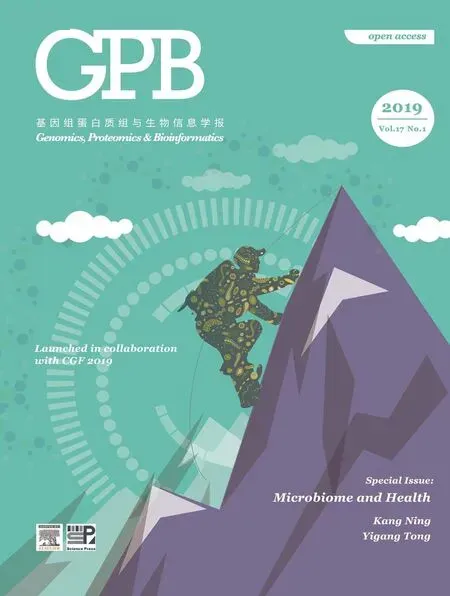The Fast Track for Microbiome Research
Kang Ning *,Yigang Tong *
1 MOE Key Laboratory of Molecular Biophysics,Hubei Key Laboratory of Bioinformatics and Molecular-imaging,Department of Bioinformatics and Systems Biology,College of Life Science and Technology,Huazhong University of Science and Technology,Wuhan 430074,China
2 College of Life Science and Technology,Beijing University of Chemical Technology,Beijing 100029,China
3 Beijing Advanced Innovation Center for Soft Matter Science and Engineering(BAIC-SM),Beijing University of Chemical Technology.Beijing 100029,China
The microbiome research is undoubtedly one of the most popular topics in biomedical research areas.This is not without reason:given that microbiome is found to be linked with and sometime causes chronic diseases and even cancers,it has become more and more obvious that microbiome plays crucial roles in human health and the surrounding environments.
As the microbiome research moves on a fast track,everyone runs fast.We are delighted to witness novel f indings and tools in microbiome research every week,many of which are ground-breaking.However,the track is more like a marathon than a sprint,like any other research area.This means that the progresses could be made step-by-step,while runners also have to be equipped well.That is,we believe applications and research tools in microbiome are both important for the current and future advancement in this f ield of study.
In this special issue of‘‘Microbiome and Health”,we aim to provide new studies in microbiome that can represent the recent development of applications and tools.Nine articles,all involving microbial communities of humans and in the surrounding environments,are collected,including two review articles and seven original research articles.These articles can be categorized into application-oriented articles and method articles.The application-oriented articles are focused on specif ic biological questions,utilizing 16S rRNA sequencing or metagenomic data to discover patterns and biomarkers from the microbiome samples.The method articles have used large collections of public data to build computational models that can facilitate in-depth metagenomic analysis.
The application-oriented articles start with a review summarizing the current knowledge on the colonization and development of gut microbiota in early life,with focus on therole of intestinal microbes in pediatric diseases[1].Li et al.[2]have also put their focus on child health.They have investigated the correlation between gut microbiota of ASD children and their mothers,showing that children with ASD had unique bacterial biomarkers,which would be of importance for the prevention of ASD via microbiota modulation.Shi et al.[3]have investigated the effects of proton pump inhibitors(PPI)on the gastrointestinal microbiota in gastroesophageal ref lux disease(GERD),and found that the PPI use in GERD patients is correlated with the changes in gastric mucosal microbiota.In addition,inulin has become one of the most popular supplements for gut microbiota intervention,and Song et al.[4]have investigated the effects of inulin-supplemented diet on gut microbiome as well as on host transcriptome.Their work on mice has shown that the inulin-supplemented diet alleviates glucose and lipid metabolism disorders by modulating the gut microbiota and interacting with host cells in ob/ob mice.
With regard to the impact of humans on microbial communities in surrounding environments,researchers from China and US have jointly investigated microbiota in the Honghu Lake,a freshwater lake in China[5],arguing that agricultural practices can negatively inf luence not only the physicochemical properties,but also the biodiversity of microbial communities in the lake.In the work by Li et al.[6],the effects of environment factors on microbial communities were also investigated.They showed that short-term antibiotic treatment shifted and diversif ied the resistome composition,increased the average copy number of antibiotic resistance genes,and increased the potential for horizontal transfer of resistance genes.
Advances of microbiome research also stem from the highthroughput sequencing technologies and big-data mining.Microbial communities can be viewed not only as groups of individual microbes,but also as collections of biochemical functions affecting and responding to an environment or host organism.Metagenomic analysis can identify the genes and pathways carried by a microbial community.Depending on the information required,by using different analytical pipelines and treatments,gene function annotation has already become automatic,self-contained,and effective analytical processes,which can rapidly produce the required output.In this regard,three method articles have been included in this special issue.The f irst one is also a review article,which has focused on the debate of enterotype,the stratif ication computational methods,and the application of enterotype on precision medicine[7].A computational model proposed by Jiang et al.[8]has attempted to f ind how microbes shape the communities.By proposing a dynamics model of microbial community based on functional genes,they have shown that functional level is important to the assembly of microbial communities.Another method proposed by Li et al.[9]aims to identify bacterial antimicrobial resistance(AMR)genes in metagenomics samples.By using Bayesian framework,they have shown that the method could accurately identify the CNVs and SNVs in AMR genes,with allele fraction signif icantly changed between the populations.
Nowadays,we have seen tremendous advances in the area of microbiome.Such progress has also been exemplif ied by these recent studies in this special issue.The f ield of microbiome has been on its fast track,and the increasing number of research activities conducted would facilitate our understanding of microbiome,health,and environments.These efforts have provided a huge amount of microbiome data,which could be used for better and more in-depth investigations on microbiome in turn,gradually lifting the level of research spirals.
Competing interests
The authors have declared no competing interests.
Acknowledgments
We thank all persons involved in composing this Special Issue,especially the authors,the reviewers,and the handling editors who facilitated the completion of this work.Special thanks also go to Drs.Fangqing Zhao and Jun Wang for their help.
 Genomics,Proteomics & Bioinformatics2019年1期
Genomics,Proteomics & Bioinformatics2019年1期
- Genomics,Proteomics & Bioinformatics的其它文章
- Acknowledgments to Reviewers 2018
- GPA:A Microbial Genetic Polymorphisms Assignments Tool in Metagenomic Analysis by Bayesian Estimation
- How Microbes Shape Their Communities A Microbial Community Model Based on Functional Genes
- Agricultural Risk Factors Inf luence Microbial Ecology in Honghu Lake
- Inulin Can Alleviate Metabolism Disorders in ob/ob Miceby Partially Restoring Leptinrelated Pathways Mediated by Gut Microbiota
- Eあects of Proton Pump Inhibitors on the Gastrointestinal Microbiota in Gastroesophageal Ref lux Disease
